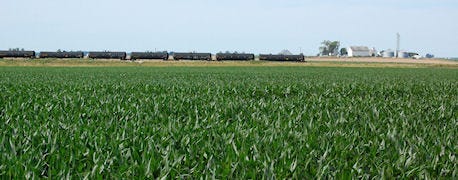
Despite drought and increased corn prices, ethanol is still 65 cents cheaper than gasoline.
What's more, E15 has yet to make a big splash; according to the Illinois Corn Growers' Association, only two fueling stations in Kansas are currently offering E15.
What gives? In early September, Illinois' average gas price was more than $4 per gallon. A cheaper blend of gasoline in the middle of a recession should be an easy sell, right?
Start posing these questions to experts and the alphabet soup begins flowing. RBOB, VOC and RVP are just a few of the acronyms that quickly induce a glazed-over look from many consumers.

It Looks Like E15 Won't Be the Catalyst For Pushing Past the Ethanol Blend Wall
ICGA's Dave Loos and Rodney Weinzierl say the big reason E15 hasn't gained traction is a result of how the EPA chose to implement the new fuel. Dave Loos is ICGA's technology and business development director. Rodney Weinzierl is their executive director. Here are the details.
Key acronyms
Volatile organic compound emissions, or VOCs, are at the crux of the explanation. In metropolitan areas across the U.S., the EPA attempts to keep VOCs emitted from tailpipes to a minimum during summer months. In warmer weather, VOCs essentially "cook" in the atmosphere, Weinzierl explains, creating ozone in the process. In Illinois, the EPA monitors VOC emissions in the metro east area of St. Louis and Chicago.
To reduce VOCs, fuel blenders use reformulated gasoline (technically "reformulated blendstock for oxygenate blending" or RBOB). RBOB gasoline comes with a lower Reid Vapor Pressure. A fuel with a lower RVP is more resistant to evaporation, and thus reduces the amount of VOCs in the atmosphere.
Here's the important part. According to Loos, when ethanol is added to gasoline, it raises the fuel's RVP by about one pound, making it less resistant to evaporation.
EPA standards set the maximum RVP for gasoline at 9 lbs. RBOB gasoline is typically at 8 lbs. Conventional gas, which is blended with ethanol outside of metro areas, is around 9 lbs. When establishing E10, the EPA waived the 9-lb RVP maximum. They did not extend the same courtesy for E15.
This dickering with RVP is monitored only during the summer months – May 15 to September 15. During winter months, fuels suppliers can legally blend conventional 9-pound RVP gas with 15% ethanol, which would result in an RVP around 10 pounds.
Come May 15, 2013, the RVP regulations come back into play. If fuel retailers want to offer E15, they'll have to source RBOB gasoline from metro areas. According to Loos, RBOB comes at a premium of 4 cents per gallon.
"The lack of a waiver for E15 makes this very difficult," Loos adds.
More Hurdles
A steady supply of RBOB gasoline is not the only hurdle standing between consumers and E15. EPA approved the new fuel only for 2001 model year automobiles and newer. Loos anticipates most retailers will have an entirely different pump for E15. With pump labels, drivers with older cars will (hopefully) know these pumps are not for them.
Some retailers may choose to add E15 as a choice on existing pumps, much like they do with premium gas. In this instance, the EPA has been clear that the situation exists where a post-2001 car owner could fill up with E15 and be immediately followed by a pre-2001 car owner. If the older car owner pumps less than four gallons of gas, the potential exists for the fuel mixture to be above a 10% ethanol blend.
Weinzierl says this is most likely if someone is filling up a gas can for a lawnmower. Even if a customer was buying gas for an older car, they'd have to pump less than four gallons of gas into a dry tank. "An unlikely scenario," he says.
The EPA decided an additional label was the best way to prevent this scenario. Also, each retail station's clerk will be charged with enforcing the no-less-than-four-gallons-of-gas-on-blender-pumps-for-cars-manufactured-prior-to-2001 rule.
With such great concern surrounding the risk of misfueling (i.e. putting the wrong gas in the tank), the EPA is spending tax payer dollars to have a third-party group survey fuel retailers regarding misfueling. Oddly enough, they'll also survey fuel stations that don't even offer E15, Loos says.
For more on this story, check out the October Prairie Farmer.
About the Author(s)
You May Also Like




